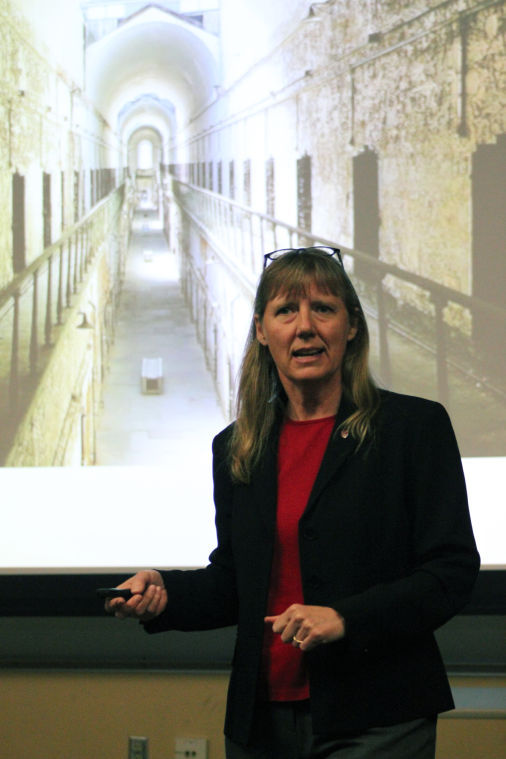People behind bars: shifting paradigms of American inmates
Professor Faith Lutze talks to students about prisons during a Common Reading lecture in CUE 203, Tuesday, March 4.
March 5, 2014
Perceptions change, but the American prison system continues to falter, a WSU professor said.
Faith E. Lutze, an associate professor in the department of criminal justice and criminology, spoke last night as part of the Common Reading lecture series. The title of Lutze’s lecture was “Perceptions of Justice: The Power of Prisons to Right a Wrong.”
“Sixty percent of our offenders will fail within three years of release,” she said. “So we might be doing something wrong.”
Lutze has researched prison life for about 25 years since she took a tour of Jackson Prison in southern Michigan. She said an experience there drastically changed her perception of the criminal justice system.
“I wanted to be a police officer,” she said, explaining her former interpretation of ‘good guys’ and ‘bad guys.’ She said that paradigm shifted during an encounter with a male inmate in the segregation ward of the prison.
“He could have spit on me,” she said. “He could have done any number of horrible things, but instead he simply said, ‘How you doin’?’”
Lutze said the experience revealed the hidden humanity that exists behind prison walls. She now views offenders on a spectrum from ‘good’ to ‘bad.’
Near to the good end are people incarcerated for non-violent crimes, including those who serve life sentences for three strikes of petty theft.
“Is this someone that we want to incarcerate for the rest of their lives?” Lutze said.
Despite this belief, she said the prison system serves a necessary purpose.
“I’ve met people in prison, I’ve met them, I’ve interviewed them, I’ve had lunch with them, I’ve taught them, and I don’t ever want to see them get out of prison,” she said. “There are aspects of the prison system that we need and should not get rid of.”
Lutze noted the number of incarcerated U.S. citizens rose drastically when President Richard Nixon declared the ‘war on drugs’ in 1971. That number today is about 2.5 million or about 5 percent of the world population.
“This is the prison population that we live with today,” she said. “That includes state, local, federal.”
Lutze explained the nature of overcrowding, saying U.S. prisons are inundated with prisoners almost as soon as they open.
“We perceive prisons as a space for men,” she said, noting 1 in 18 men in the U.S. is incarcerated or under supervision of some kind. For women, that figure is 1 in 89.
Lutze also commented on perceptions of race in the criminal justice system.
“Prison sentences are disproportionately used on African Americans,” she said. “And it doesn’t matter whether you think it’s due to discrimination or whatever. That is shameful.”
Junior criminal justice major Kaylan Forbis said it is important that people adjust their perceptions of inmates.
“I believe we have the programs, and we’re starting to do research,” Forbis said. “So I think we’re headed in the right direction. I believe there’s some deficits in the way offenders are treated.”
Karen Weathermon, a co-chair of the Common Reading program, said most people know little about the U.S. prison system.
“I think largely we sort of just put it away out of mind,” Weathermon said. “So honestly I don’t know how we could improve because I know so little about it.”
Weathermon, too, said the number of incarcerated African Americans led her to question whether prejudice exists in the justice system.
“It really makes me go ‘hmm’ at the notion that justice is blind,” she said.















